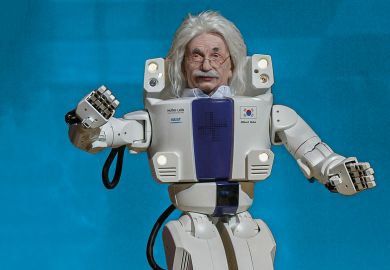Amid all the other problems confronting humanity, the release of ChatGPT has got many people very worried about carbon-based life’s future employability – not to mention its metaphysical status. Even Elon Musk believes that we are “not far off from dangerously strong AI”.
Throughout the technological age we have heard talk of transformations unlike anything the world has known before. Yet even as these new waves of innovation sweep across society and education, traditional forms of assessment remain a staple of the university environment. Even with the advent of so-called essay mills and the supposed rewiring of digital natives’ brains, most university instruction remains focused on the acquisition of knowledge, culminating in the production of summative written outputs.
But what will happen when AI has the ability to generate such outputs so effectively that readers cannot distinguish between human- and machine-generated content? ChatGPT (chat generative pre-trained transformer) isn’t quite that sophisticated, but it has made the coming of technologies with superhuman powers feel much closer. Its listed capabilities already include essay-writing, test-taking and compositions of poetry and music, alongside more mathematical functions, and it isn’t hard to imagine a future version so advanced that it can replicate anyone’s style or voice, from the brain science of David Eagleman to the unique linguistics of Donald Trump.
In other words, ChatGPT may well soon seem as outdated as 1980s Superman movies compared with today’s computer-enhanced versions. And it is natural to fret about how universities will find the X-ray vision to spot essays churned out by machines faster than Clark Kent could type a Daily Planet story – and how they will produce graduates with a fighting chance in the workplace against such mechanical superpowers.
It may be reassuring, however, to reflect on the fact that education has been incorporating and re-imagining the threats and possibilities of tech for decades. There was a time, after all, when we feared similar battles with such newbies as smartphones and Wikipedia. Yet we adapted our practices around these and even made the most of them.
Higher education does not and should not exist in a bubble; critical engagement with the real world should be brought into the classroom at every opportunity. We as educators always need to find imaginative ways of making technologies a friend to students’ learning, not a threat, and AI is no different.
AI will not fundamentally change teaching any more than previous technologies have done. Though today’s teaching equipment might look very different from the chalkboards of the past, it is pedagogy, not technology, that has improved many aspects of learning. It is a fact that today’s higher educational environment is an interactive one, shaped as much by breakout spaces as lecture rooms.
As AI improves further, assessment will probably need to change. But that is likely to be a pedagogical improvement, too; in today’s market-driven model of education, assessment of written outputs can feel very high stakes, formulaic and depersonalised at times. A more socially just interpretation of teaching and learning would see students engaging with knowledge for self-development; if advanced AI can help in that process, universities should embrace it rather than try to keep students away from it.
Moreover, while, historically, higher education may have been slow to react to technological change, the pandemic forced universities to discover their ability to adapt to new circumstances at very short notice. And, out of that, we came to realise that disruption does not have to be a negative word. Sometimes it can be the mother of transformation.
Right now, we are witnessing the birth pangs of a truly great disruptor. But though we might soon be holding onto a digital Superman’s cape, the direction of travel will remain the same. The principles of teaching will always trump the supposed threat of new technologies because the greatest resource in education is the human presence. It will still take a long time for AI to develop neural networks as sophisticated as a human brain – if it ever does.
Therein lies the greatest superpower that humans have: the power to think critically. That is what we need to do now to harness the power of this latest generation of tech. Through doing so, we also give our students the criticality that they will need to thrive in a future where super-tech plays an ever-increasing role in their daily lives.
Paul Breen is a digital learning developer at UCL. He is author of Developing Educators for the Digital Age (University of Westminster Press, 2018).
Register to continue
Why register?
- Registration is free and only takes a moment
- Once registered, you can read 3 articles a month
- Sign up for our newsletter
Subscribe
Or subscribe for unlimited access to:
- Unlimited access to news, views, insights & reviews
- Digital editions
- Digital access to THE’s university and college rankings analysis
Already registered or a current subscriber?








